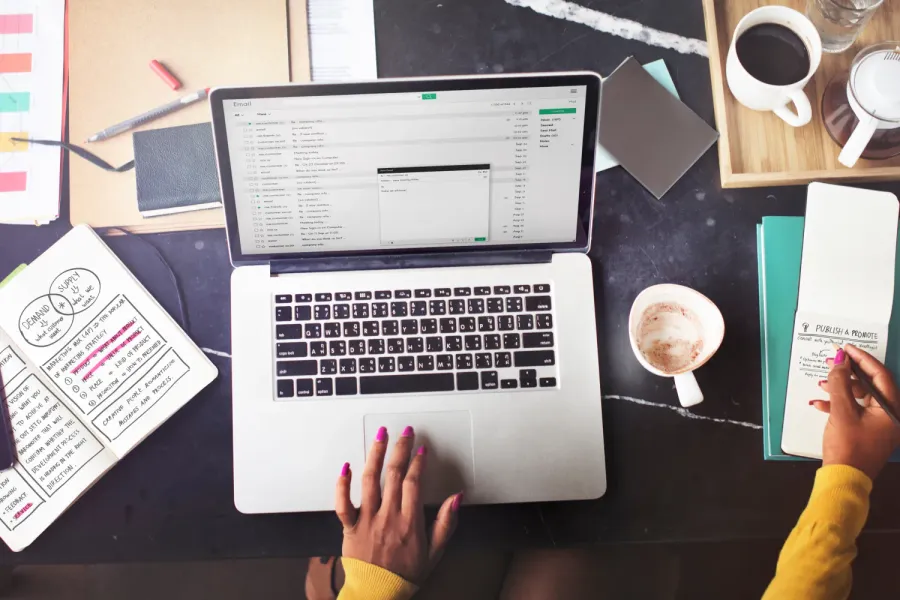
Email is one of the most ubiquitous methods of communication, with 99% of email users checking their email every day. Creating a template for a formal email saves you time and creates consistency across the emails you write.
In this guide we'll take a look at what formal emails are, when they're appropriate, the elements of a formal email, and how you can build the perfect formal email template.
What is a formal email?
A formal email is an email commonly used to address a business associate. This can be a person you don't know at all, don't know well, or an authority figure, whether in a business setting or not.
A formal email adheres to email etiquette that is polite, concise, and clearly written. When writing a formal email, you'll want to avoid using emojis, slang, or informal terms.
When is a formal email appropriate?
Here are some typical work and personal scenarios in which formal emails would be appropriate:
- An introduction: You might want to introduce two people in a respectful way, whether they are colleagues, clients, or acquaintances. Making a good first impression, even in digital form, is an important first step.
- A job inquiry: If you're on the hunt for a job, you'll want to write a formal email.
- Sales emails: Writing to a potential customer or prospect requires tact. A formal email can show the recipient that their time is valuable.
- An apology: Addressing an unfortunate situation is tough for both parties. By keeping it formal, you can show your condolences and convey respect.
- Termination of employment: Whether things aren't working out with an employee or you're leaving your employer, a formal email helps maintain levels of respect for both parties. As an employer, you can break the news with a professional tone by sticking to the facts. As an employee, you can submit a letter of resignation in a professional way that ensures your departure is on good terms.
How to write a professional email
A professional email adheres to three basic guidelines:
Keep it concise
A formal email should be straightforward and stick to the point. It should be as simple as telling them who you are and why you're reaching out.
Be polite
Formal emails are about being professional and polite. Use proper grammar and spelling, and don't use emojis or abbreviated words.
Write with intention
A formal email is clear.
Proofread your email before sending it to ensure that your message will be understood. .
How to write a cold email
A cold email is a message sent without a heads-up or prior introduction to the recipient. It is a way to introduce yourself for the first time and invite conversation or collaboration.
Let's break down the elements of a cold email:
- Subject line: Keep your subject line to a few simple words, explicitly stating your purpose for writing. If requesting a meeting for a job or sales opportunity, simply write "Meeting Request."
- Greeting: When addressing someone for the first time you'll want to show your respect by starting off with a "Dear [name]" (or "Dear Team" if you're contacting a general inbox. Avoid using "Hello" or other potentially informal greetings.
- Opening line: Introduce yourself straight away. Give your full name, company, and job title if suitable.
- Body: The body should communicate the purpose of your email. Be clear and separate your points into paragraphs, knowing that you might only have your readers' attention for a few seconds.
- Sign off: Close your email with a respectful acknowledgment in the form of a "Thank you," "Sincerely," or "Best regards."
- Signature: Include your signature to reinforce your name, job title, and company. When appropriate, you should also include, your email address, phone number, website, physical address, and social media.
Sending a follow-up email
Sending follow-up emails is an important skill. You might send a follow-up after a meeting was scheduled, new information is at hand,, or to check in with your contact after some time has passed.
Let's break down the elements of a follow-up email:
- Subject line: When addressing someone with a follow-up, you can keep your email subject line simple. If you're replying to an email thread, you don't need to change the subject line. If it's been some length of time and you're addressing this person again but for another reason, keep your subject line clean. Something like "Next steps," "Thank you for your time," or "Here's the information I mentioned" are straightforward ways to address your contact.
- Greeting: Like with a cold email, you'll want to keep greetings formal. Match the same greeting you used in your first contact.
- Opening line: The opening line of a follow-up is a chance to restate who you are — e.g. "This is [name], wanting to reach out again." Noting that you've been in contact before will give them helpful context.
- Body: Again, keep it simple and make sure that you're speaking with intention. Request your desire for a meeting if that's your goal, or simply state your gratitude if you've just received a meeting with the follow-up information you want to provide them with.
- Sign off and signature: The closing of your email should be similar to your cold email. Thank the correspondent, and include your contact information in your signature.
What is an example formal email template?
Here's a template for a standard first introduction:
Subject: [Summary of the purpose of the email, in a sentence or less]
Dear [Name of recipient],
My name is [your full name], [job title] at [company name]. I am [explain why you're writing to them].
[A brief statement of intent or request. Keep this to one or two short paragraphs if possible.]
Thank you for your time,
[Your name], [job title] at [company name]
[Your contact information]
This template can be updated with greetings and thanks of your choice, and your specific information. Templating your business emails can save you time and ensure that important information is provided every time.
You can save yourself even more time by using an email signature. This leaves you with just the subject, greeting, and body to focus on.
Save even more time
Getting your inbox under control can feel like a difficult or even impossible task, with most people spending up to five hours per day on email.
Try Superhuman, the fastest email experience ever made. Get through your email twice as fast as before, reply 2 days sooner, and save more than 4 hours every single week.




